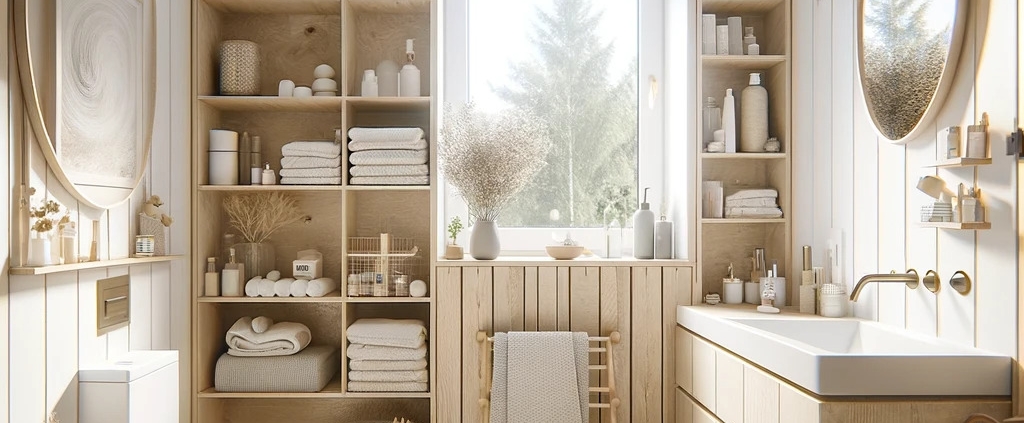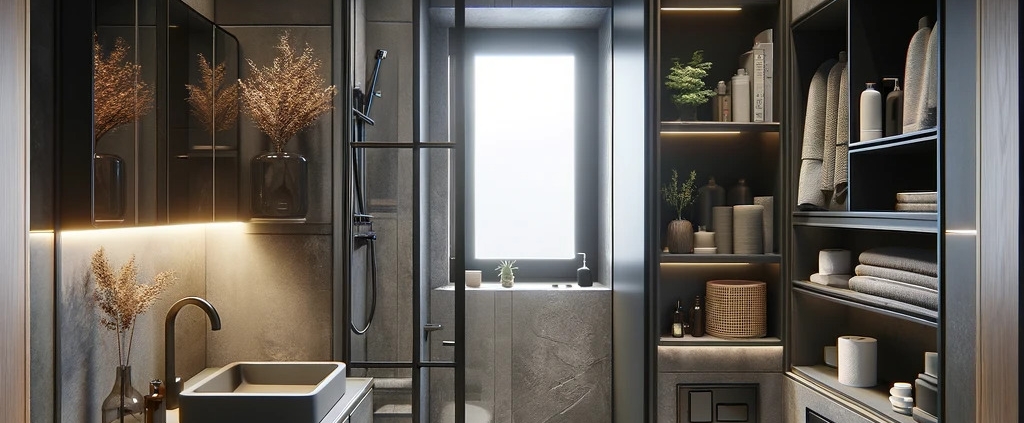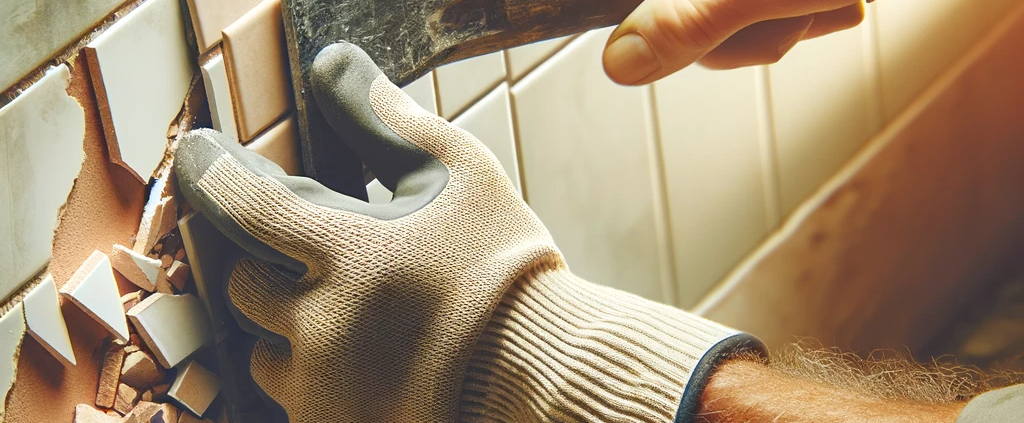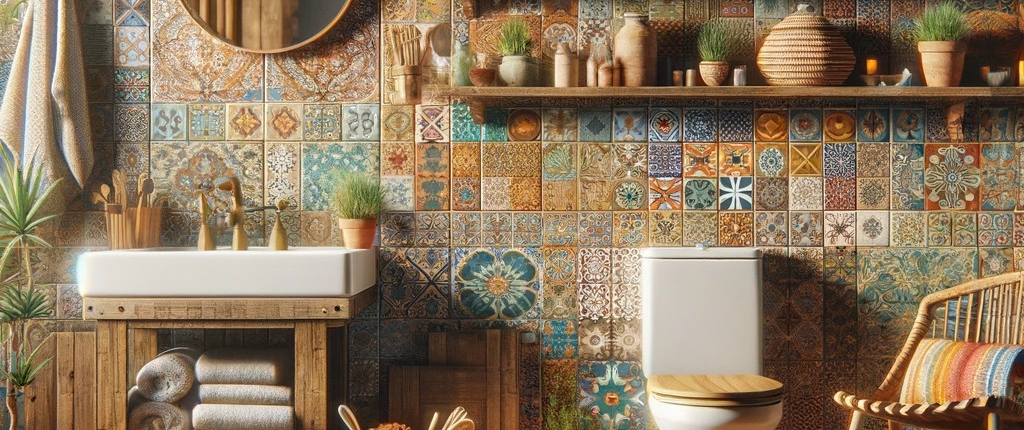DIY Bathroom Renovation: The Journey
Embarking on a DIY bathroom renovation can be an exciting and rewarding endeavor. It’s an opportunity to transform a vital space in your home, tailor it to your personal style, and perhaps even increase your property’s value.
Why Choose DIY for Your Bathroom Renovation?
Choosing to tackle a bathroom renovation on your own can offer a range of benefits:
- Cost Savings: One of the most compelling reasons to go the DIY route is the potential to save on labor costs. By handling the project yourself, you can allocate a larger portion of your budget to high-quality materials or additional features.
- Personalization: DIY projects afford you the freedom to customize every aspect of your renovation according to your specific tastes and needs. From the color scheme to the fixtures, every detail can reflect your personal style.
- Skill Building: A DIY renovation is a chance to develop new skills or hone existing ones. Whether it’s tiling, plumbing, or electrical work, the experience can be both educational and empowering.
- Flexibility: Managing the renovation yourself means you can work at your own pace and on your own schedule, making it easier to accommodate the renovation process into your daily life.
Before diving in, consider the potential return on investment. The average bathroom renovation cost may vary, but a well-executed update can significantly boost your home’s value.
Assessing Your Skill Level and Readiness
Before you begin tearing out tiles and shopping for new vanities, it’s crucial to assess your skill level and readiness for the project ahead:
- Evaluate Your Skills: Honestly consider your abilities in carpentry, plumbing, electrical, and other relevant areas. If you’re a novice, you might start with a small bathroom renovation to build your confidence.
- Research and Learn: Take the time to educate yourself on the various aspects of bathroom renovations. There are countless resources available to guide you through the process.
- Time Commitment: Ensure you have a realistic understanding of the time required to complete the renovation. If your availability is limited, it may affect the project’s timeline.
- Tools and Resources: Do you have the necessary tools for the job, or can you obtain them? Make a list of what you’ll need and verify that you have access to all the essential equipment.
- Permits and Regulations: Familiarize yourself with local building codes and permit requirements. Some aspects of the renovation may legally require professional involvement.
- Support System: Consider if you have a support system in place for tasks that might require an extra pair of hands or for advice when you encounter challenges.
Assessing your capabilities and preparing accordingly sets a strong foundation for a successful DIY bathroom renovation. For inspiration and practical tips, explore a variety of bathroom renovation ideas to help you design a space that meets both your aesthetic and functional needs. With careful planning and a clear understanding of your objectives and limitations, you can embark on this renovation journey with confidence.
Planning Your DIY Bathroom Renovation
Embarking on a DIY bathroom renovation requires thorough planning to ensure the process is smooth and the outcome is successful. This phase is the foundation of your renovation journey, where you will set a budget, create a timeline, and design your new bathroom layout.

Setting a Budget
One of the first steps in planning your DIY bathroom renovation is establishing a budget. This financial plan will dictate the scope of your renovation and the materials you can afford. Start by itemizing each aspect of the renovation, such as materials, tools, and potential labor costs for tasks you may need assistance with.
Here’s a simplified table to help you organize your budget:
| Expense Category | Estimated Cost |
|---|---|
| Materials | $X,XXX.XX |
| Tools and Equipment Rental | $XXX.XX |
| Contingency Fund (10-15% of total budget) | $X,XX.XX |
| Miscellaneous | $XXX.XX |
| Total | $XX,XXX.XX |
Remember to allocate a portion of your budget for unforeseen expenses. A contingency fund of 10-15% of the total budget is advisable to cover unexpected costs. For more detailed information on what to expect, check out our guide on bathroom renovation cost.
Creating a Timeline
Your renovation timeline is a schedule that outlines when each phase of the project will be completed. It’s essential to be realistic about how much time you can dedicate to the renovation. Consider the complexity of tasks, your skill level, and whether you’ll be doing the work on weekends or after your regular job.
To help manage your time effectively, break down the renovation into smaller tasks and set deadlines for each. Here’s an example:
| Task | Duration | Deadline |
|---|---|---|
| Demolition | 2 days | MM/DD/YYYY |
| Plumbing Updates | 3 days | MM/DD/YYYY |
| Tile Installation | 5 days | MM/DD/YYYY |
| Painting | 2 days | MM/DD/YYYY |
| Fixture Installation | 2 days | MM/DD/YYYY |
By creating a timeline, you can pace the renovation and minimize disruptions in your daily life.
Designing Your New Bathroom Layout
Designing your new bathroom layout is one of the most exciting parts of the planning process. Whether you’re working with a compact space or a more expansive area, thoughtful design is key. Consider the placement of fixtures, storage solutions, and lighting.

Think about the flow of the space and how you’ll move around in it. Do you need to make structural changes or can you work with the existing layout? This is the time to explore different bathroom renovation ideas that can maximize functionality and aesthetics.
For those with small bathrooms, reviewing small bathroom renovation ideas can provide creative solutions to make the most of limited space.
As you plan, use graph paper or renovation software to sketch out your ideas. This visual representation will help you imagine the final result and serve as a reference throughout the renovation process.
Getting Started with Your Renovation
Embarking on a DIY bathroom renovation can be an exciting and rewarding endeavor. Before diving in, it’s crucial to prepare your space and gather all the necessary tools and materials.
Preparing Your Bathroom for Renovation
Preparing your bathroom for renovation is the first step towards transforming your space. Begin by clearing out all personal items, toiletries, and removable fixtures. It’s important to create a clean and clutter-free environment to ensure a safe and efficient workspace.
Next, take the time to protect any areas that you don’t plan to renovate. Cover floors and adjoining surfaces with drop cloths or plastic sheeting to guard against dust and debris. Additionally, consider turning off the water supply to prevent any accidental leaks during the renovation process.
If you’re planning a more substantial overhaul, such as a small bathroom renovation, ensure that you have alternative facilities available for the duration of the project, as your bathroom may be out of commission.
Essential Tools and Materials
Having the right tools and materials is essential for a successful DIY bathroom renovation. Here’s a list of items you’ll likely need:
- Safety Equipment: Gloves, goggles, and ear protection.
- Demolition Tools: Hammer, pry bar, and sledgehammer.
- Power Tools: Drill, saw, and sander.
- Tile Tools: Tile cutter, spacers, and grout float.
- Plumbing Tools: Wrenches, pipe cutter, and sealant.
- Painting Supplies: Brushes, rollers, and painter’s tape.
- Building Materials: Tiles, grout, caulk, and drywall.
| Tool Type | Examples |
|---|---|
| Safety Equipment | Gloves, goggles, dust mask |
| Hand Tools | Hammer, screwdrivers, tape measure |
| Power Tools | Drill, circular saw, jigsaw |
| Plumbing Tools | Pipe wrenches, plunger, Teflon tape |
| Tile Tools | Tile cutter, notched trowel, tile spacers |
Ensure that you have all the necessary materials before beginning your renovation to avoid any disruptions. You may also need to purchase or rent specialized tools depending on the scope of your project. For an estimate on the potential costs of tools and materials, you can refer to bathroom renovation cost.
Remember, while it’s important to have a comprehensive toolkit, it’s just as crucial to know how to use each tool effectively. Take the time to familiarize yourself with the proper operation of each item to ensure your renovation goes smoothly.
Armed with the right preparation and tools, you’re now ready to take on the challenge of renovating your bathroom. Keep in mind that a well-planned approach and attention to detail are key to achieving the bathroom makeover you envision. For more inspiration and ideas, explore our bathroom renovation ideas to help guide your project.
Step-by-Step Guide to DIY Bathroom Renovation
Embarking on a DIY bathroom renovation can be an exciting and rewarding project. With the right approach, you can transform your bathroom into a space that reflects your personal style and meets your functional needs.
Demolition and Removal
The first phase in your renovation journey involves the demolition and removal of your current bathroom features. Safety should be your top priority during this process. Ensure you have the necessary protective gear, such as gloves, safety glasses, and a dust mask.
- Clear out all movable items.
- Disconnect and remove fixtures like the toilet, vanity, and bathtub.
- Carefully take down any tile and drywall that you plan to replace.
Remember to turn off the water supply before removing plumbing fixtures to avoid any unexpected leaks. Dispose of debris responsibly and recycle materials when possible.

Plumbing and Electrical Considerations
Before proceeding with new installations, address any plumbing or electrical updates. This might include relocating pipes or wiring for new fixtures.
- Evaluate the condition of existing plumbing and electrical systems.
- Plan for any new fixtures and ensure that your plumbing and electrical systems can accommodate these changes.
- Consider consulting with a licensed professional to ensure that all work complies with local building codes.
For more detailed guidance on plumbing and electrical work, check out our article on small bathroom renovation.
Installing Flooring and Tiles
Choosing the right flooring and tile can set the tone for your bathroom’s overall design. When it comes to installation:
- Ensure the subfloor is level and clean.
- Begin by laying out your tiles to plan the layout and make any necessary cuts.
- Apply mortar or adhesive, set your tiles in place, and allow them to set according to the manufacturer’s instructions.
- Once the tiles are set, apply grout, wipe off any excess, and seal the grout to protect it from moisture and mold.
For creative and practical tiling ideas, explore our bathroom renovation ideas.
Setting Up Fixtures and Features
Installing new fixtures and features is where your bathroom truly begins to take shape.
- Install your bathtub or shower unit, making sure to seal and caulk all edges to prevent water damage.
- Mount the vanity, sink, and faucets, ensuring they are secure and properly connected to your plumbing.
- Fit the toilet and any additional cabinetry or shelving you desire.
As you install each fixture, refer to the manufacturer’s guidelines for proper installation procedures. This ensures longevity and functionality of your bathroom components.
Throughout your DIY bathroom renovation, keep in mind the bathroom renovation cost to stay within your budget. With patience and careful planning, your DIY project can lead to a beautifully renovated bathroom that enhances your home’s value and your everyday living experience.
Finishing Touches
After the heavy lifting of your DIY bathroom renovation is complete, it’s time to focus on the finishing touches that will truly make the space your own. These final steps include painting, decorating, installing accessories, and cleaning up.
Painting and Decorating
Painting the bathroom can dramatically change the look and feel of the space. When selecting paint, ensure you choose a moisture-resistant variety suitable for bathroom environments to prevent mold and peeling.
| Step | Description |
|---|---|
| 1 | Tape off trim and fixtures |
| 2 | Apply primer if necessary |
| 3 | Paint walls and ceiling with even coats |
| 4 | Remove tape and touch up edges |
Once the paint is dry, it’s time to decorate. Consider your overall design theme from your earlier plans, which could be modern, rustic, or anything in between. Add wall art, plants, and other decor elements that complement your style and add personality to the room. For more design inspiration, visit bathroom renovation ideas.
Installing Accessories
The right accessories can enhance both the functionality and aesthetics of your bathroom. Towel racks, toilet paper holders, and shower caddies are not only practical but also contribute to the overall design.
- Choose accessories that match the finish of your fixtures for a cohesive look.
- Ensure that items like grab bars and towel racks are securely anchored to walls to support the weight of wet towels or provide stability as needed.
- Consider the placement of each accessory for both convenience and visual balance.
The Final Cleanup
After the renovation work is completed, a thorough cleanup is necessary to prepare your new bathroom for use.
- Remove all debris and dust from surfaces.
- Clean the newly installed flooring and tiles, paying attention to removing any grout haze.
- Wipe down fixtures to remove fingerprints and smudges.
- Ensure all tools and materials are removed from the bathroom.
A detailed cleanup not only provides a pristine look to your newly renovated bathroom but also ensures that you have a safe and hygienic space ready for use.
The transformation of your bathroom is now complete, thanks to the time, effort, and creativity you’ve invested. With these finishing touches, your renovated bathroom is not only a reflection of your DIY skills but also a space tailored to your personal taste and comfort. For guidance on budgeting for your project, consider reading about bathroom renovation cost. If you’ve worked on a smaller space, our article on small bathroom renovation may offer additional insights for maximizing your bathroom’s potential.
Safety and Maintenance
When undertaking a DIY bathroom renovation, safety should be your top priority, followed by proper maintenance to ensure the longevity of your newly renovated space.
Safety Tips During Renovation
Your wellbeing is paramount during a bathroom renovation. Here are essential safety tips to keep in mind:
1- Personal Protective Equipment (PPE):
- Wear safety goggles to protect your eyes from debris.
- Use gloves to shield your hands from sharp objects and chemicals.
- Don ear protection when using loud power tools.
- Don a dust mask or respirator in dusty environments or when handling insulation.
2- Electrical Safety:
- Always turn off the power at the circuit breaker before working on electrical components.
- Use a voltage tester to ensure wires are not live before handling them.
2- Chemical Safety:
- Read labels and follow instructions when using chemicals like adhesives or cleaners.
- Ensure proper ventilation when working with volatile substances.
3- Tool Safety:
- Keep tools in good condition and use them for their intended purpose.
- Securely fasten ladders and scaffolding to prevent falls.
4- Awareness of Hazards:
- Be aware of potential hazards such as exposed nails, slippery floors, and uneven surfaces.
By adhering to these safety precautions, you minimize the risk of accidents and injuries during your DIY bathroom renovation. For more safety guidelines and how to tackle a small bathroom renovation, visit our detailed articles.
Maintaining Your Newly Renovated Bathroom
Post-renovation, maintenance is key to preserving the beauty and functionality of your bathroom. Follow these maintenance tips:
1- Regular Cleaning:
- Clean surfaces, fixtures, and floors regularly to prevent mold and mildew buildup.
- Use appropriate cleaners for different materials to avoid damage.
2- Moisture Control:
- Ensure your bathroom is well-ventilated to handle moisture.
- Regularly check and maintain exhaust fans.
3- Sealant and Grout Maintenance:
- Inspect and repair caulking and grout lines to prevent water damage.
- Reseal areas around the bathtub and sink as needed.
4- Plumbing Checkups:
- Monitor for leaks or slow drains and address issues promptly.
- Clean faucet aerators and showerheads to maintain water flow.
5- Hardware and Fixtures:
- Tighten loose cabinet hardware and faucet handles.
- Check and replace worn washers or seals on taps to prevent dripping.
By maintaining these aspects of your bathroom, you prolong the lifespan of your renovation efforts. For ideas on how to enhance your renovation or for estimates on bathroom renovation cost, our resources can provide you with additional insights.
Remember, while you can handle many aspects of a bathroom renovation, some challenges may require professional assistance. If you encounter complex plumbing or structural issues, it’s wise to consult with or hire experts to ensure the job is done safely and correctly. Explore our bathroom renovation ideas for further inspiration and guidance on when to call in the professionals.
Troubleshooting Common DIY Renovation Challenges
Dealing with Unexpected Issues
During your DIY bathroom renovation, you may encounter unforeseen issues that can throw a wrench in your plans. It’s important to remain calm and troubleshoot these problems methodically.
- Water Damage: Upon demolition, you might discover water damage. Assess the extent and address it by replacing compromised structures.
- Mold and Mildew: If you find mold or mildew, it’s essential to remove it completely and treat the area to prevent recurrence.
- Plumbing Surprises: Sometimes, the plumbing doesn’t go exactly where you thought it did. In these cases, consult plumbing diagrams or consider hiring a professional to reroute pipes.
- Electrical Issues: Outdated wiring can be hazardous. If you’re not experienced with electrical work, this is the time to get professional help.
When facing these challenges, refer to guides on bathroom renovation cost to adjust your budget accordingly.
When to Call the Professionals
While many aspects of a bathroom renovation can be handled on your own, there are times when calling in the professionals is the best course of action.
| Issue | DIY Feasible | Call the Professionals |
|---|---|---|
| Simple Repainting | Yes | No |
| Basic Tiling | Yes | No |
| Extensive Water Damage | No | Yes |
| Major Plumbing Work | No | Yes |
| Electrical Wiring | No | Yes |
| Structural Alterations | No | Yes |
- Permits and Codes: If any part of your renovation requires permits or needs to meet local building codes, professional insight is invaluable.
- Major Structural Changes: For any changes that might affect the structural integrity of your home, such as removing a load-bearing wall, it’s crucial to consult with an expert.
- Complex Plumbing and Electrical Work: These systems can be intricate and require specialized knowledge. Mistakes can be costly and dangerous.
- High-End Finishes: If you’re installing expensive materials and want to ensure they’re installed correctly, a professional touch can make all the difference.
For inspiration on when to DIY versus hire a professional, explore small bathroom renovation and bathroom renovation ideas. Remember, the key to a successful renovation is knowing your limits and when to seek help.

